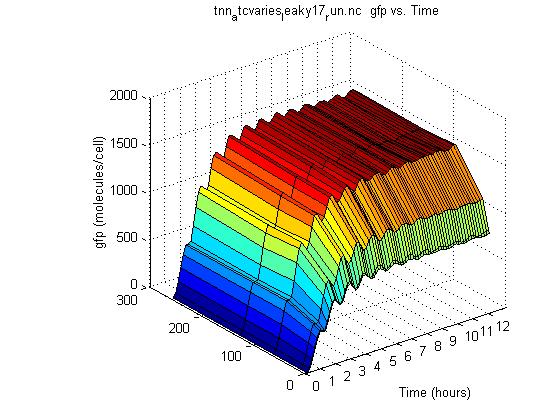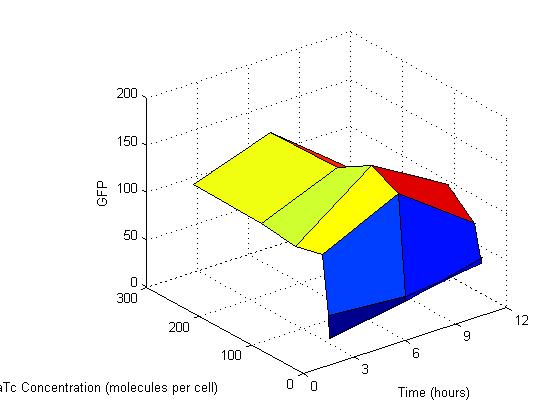Minnesota/2 July 2009
From 2009.igem.org
| Line 6: | Line 6: | ||
|} | |} | ||
'''Patrick'''<br> | '''Patrick'''<br> | ||
| - | Today I re-looked at some of the kinetic factors that we can change to see if changing the model may have affected how they effect the graph. I submitted eight models | + | Today I re-looked at some of the kinetic factors that we can change to see if changing the model may have affected how they effect the graph. I submitted eight models today as described below:<br> |
| - | '''smad_ttn_tetRo_u/d''' - These two models looked at the affects of changing the rate of synthesis of tetR2 in the cell.<br> | + | '''smad_ttn_tetRo_u/d''' - These two models looked at the affects of changing the rate of tetR2 being eliminated from the cell. Specifically reactions 35, 36, 37 mentioned before. The kinetic constants were moved up or down by an order of magnitude (k = 0.00028881 1/s initially).<br> |
| + | |||
| + | '''smad_ttn_tetRin_u/d''' - These two models looked at the affects of changing the rate of synthesis of tetR2 (reaction 44) in the cell, by either moving the kinetic constant up an order of magnitude (1E-11 to 1E-10), or down an order of magnitude (1E-11 to 1E-12).<br> | ||
| + | |||
| + | '''smad_ttn_aff_u/d''' - These two models changed the kinetic constants for tetR2 affinity for tetO1 and tetO2. The reactions affected are reaction 16, 18, 20, 26, 28, 30 as mentioned before. Moving the kinetic constants (which range from 0.001 1/s to 10000 1/s) up will allow tetO1 and tetO2 to release from tetR2 more easily. Moving the kinetic constants down will make tetO1 and tetO2 bind more tightly.<br> | ||
| + | |||
| + | '''smad_ttn_test1/2''' - These two models extend the smad_ttn_tetRin_*.nc models. For Test2 I looked at changing reactions 35, 36, 37, and also 42 and 43 down an order of magnitude. These reactions represent every way tetR2 can be permanently eliminated from the cell (besides dilution from cell division). Test1 also moved reaction 44 (--> TetR2, synthesis of tetR2) down an order of magnitude.<br> | ||
| + | |||
| + | The results for these models are expected tomorrow.<br> | ||
'''Ben'''<br> | '''Ben'''<br> | ||
[[Image:Tnnatcvariesleaky17.jpg|480px]][[Image:Tnnexperiment.jpg|480px]]<br> | [[Image:Tnnatcvariesleaky17.jpg|480px]][[Image:Tnnexperiment.jpg|480px]]<br> | ||
Revision as of 16:01, 30 July 2009
| Back to Notebook Home | |
| Go to Previous Day (July 1) | Go to Next Day (July 3) |
Patrick
Today I re-looked at some of the kinetic factors that we can change to see if changing the model may have affected how they effect the graph. I submitted eight models today as described below:
smad_ttn_tetRo_u/d - These two models looked at the affects of changing the rate of tetR2 being eliminated from the cell. Specifically reactions 35, 36, 37 mentioned before. The kinetic constants were moved up or down by an order of magnitude (k = 0.00028881 1/s initially).
smad_ttn_tetRin_u/d - These two models looked at the affects of changing the rate of synthesis of tetR2 (reaction 44) in the cell, by either moving the kinetic constant up an order of magnitude (1E-11 to 1E-10), or down an order of magnitude (1E-11 to 1E-12).
smad_ttn_aff_u/d - These two models changed the kinetic constants for tetR2 affinity for tetO1 and tetO2. The reactions affected are reaction 16, 18, 20, 26, 28, 30 as mentioned before. Moving the kinetic constants (which range from 0.001 1/s to 10000 1/s) up will allow tetO1 and tetO2 to release from tetR2 more easily. Moving the kinetic constants down will make tetO1 and tetO2 bind more tightly.
smad_ttn_test1/2 - These two models extend the smad_ttn_tetRin_*.nc models. For Test2 I looked at changing reactions 35, 36, 37, and also 42 and 43 down an order of magnitude. These reactions represent every way tetR2 can be permanently eliminated from the cell (besides dilution from cell division). Test1 also moved reaction 44 (--> TetR2, synthesis of tetR2) down an order of magnitude.
The results for these models are expected tomorrow.
 "
"

